A NIC report developed to provide timely insights from owners and C-suite operators on the pulse of seniors housing and skilled nursing sectors.
This report marks the third installment of findings from NIC’s weekly Executive Survey of operators in seniors housing and skilled nursing. The report highlights the findings from responses collected at the beginning of the pandemic to now as operators experience changing market conditions due to the COVID-19 threat to residents, staff and business operations; effects of social distancing mandates from state and local governments and seniors housing and care organizations themselves; and the economic effects of shuttered non-essential businesses on local economies.
Summary of Insights and Findings
Occupancy rates declined and move-in rates decelerated for many organizations in Wave 3, with data showing distinctive downward trends since the survey began on March 24, 2020.
- In Wave 3, a decline in occupancy rates from the prior month occurred across all care segments, with the deepest declines reported for the nursing care segment. In Wave 3, about 40% of organizations reporting on their nursing care beds note an occupancy decline of ten percent or more from the prior month, up from about 20% reporting an occupancy decline of ten percent or more in Wave 2.
- Regarding the change in occupancy from one week ago, the independent living segment saw the most occupancy stability. However, roughly one-third of memory care units, and under one-half to two-thirds of assisted living units and nursing care beds note a decline in occupancy compared to the prior week, suggesting continued weakness in the near future.
- More organizations report the pace of move-ins decelerated in the past 30-days in Wave 3 than in the prior two waves of the survey. Two-thirds to one half of respondents attribute the deceleration in move-ins to a slowdown in leads conversion/sales, or resident or family member concerns. Overall, slightly fewer respondents in Wave 3 cited an organization-imposed ban on moving new residents into their communities, and slightly more cited resident or family member concerns than in Wave 2.
- The nursing care segment saw the largest deceleration of move-ins in the past 30-days. Reasons cited by respondents include fewer hospitals discharging patients to post-acute care settings for rehabilitative therapy as hospitals defer elective surgeries due to the pandemic, and positive or suspected COVID-19 related moves of residents to isolated units. Nearly one-half of organizations with any nursing care beds cited an organization-imposed ban on move-ins, and nearly one-quarter cited a government-imposed ban on admitting new residents.
- A larger share but still minority of respondents in Wave 3 report an acceleration in move-outs in the past 30-days compared to prior waves of the survey. Roughly two-thirds to three-quarters of organizations reporting on their independent living, assisted living and memory care segments saw no change in move-outs—a steady decline from Wave 1 to Wave 3. Just over one-third of organizations with nursing care beds note an acceleration in move-outs in Wave 3.
- Most organizations continue to mitigate staffing shortages by increasing overtime hours, offering flexible work hours, and remote work where possible. Fewer organizations in Wave 3 than the prior two waves of the survey are hiring agency or temporary staff and professionals from other industries. However, more organizations are beginning to offer additional paid sick leave to support property staff. Survey write-in comments indicate other tactics are being employed such as increasing wages, offering shift bonuses and incentive pay, access to on-site groceries and meals, emergency financial support programs, and temporary housing.
- Like previous waves of the survey, one-half of respondents in Wave 3 expect no change in their development pipeline going forward, however one-quarter expect their development pipeline to decrease citing uncertainty as the primary reason. Some of the respondents shared concerns about the economy, restrictions on moving new residents in, access to capital/debt, and cashflow and liquidity issues. NIC MAP® data has shown a deceleration in new construction relative to inventory trending for several quarters.
- A recent NIC blog post entitled “We Feel We Are Alone in a War Zone” incorporates comments from earlier survey respondents that reflect the impact of the COVID-19 crisis on a human level. One of the key concerns reflected in survey comments is a lack of available, accurate, and timely testing. Survey respondents also worry about the effect that the pandemic is having on already strained labor force issues.
Wave 3 Survey Demographics
- Responses were collected April 13-19, 2020 from owners and C-suite executives of 105 seniors housing and skilled nursing operators from across the nation.
- More than half of respondents were exclusively for-profit providers (59%), about one-third (36%) were exclusively nonprofit providers, and 5% operate both for-profit and nonprofit seniors housing and care organizations.
- Owner/operators with 1 to 10 properties comprise 63% of the sample. Operators with 11 to 25 properties make up 24% while operators with 26 properties or more make up 13% of the sample.
- Many respondents in the sample report operating combinations of property types. Across their entire portfolios of properties, 73% of the organizations operate seniors housing properties (IL, AL, MC), 36% operate CCRCs (aka Life Plan Communities), and 34% operate nursing care properties.
Key Survey Results
Change in Occupancy by Care Segment
Respondents were asked: “Considering the entire portfolio of properties, overall, my organization’s occupancy rates by care segment are… (Most Recent Occupancy, Occupancy One Month Ago, Occupancy One Week Ago, Percent 0-100)”
- Approximately one-half to two-thirds of organizations reporting on their independent living, assisted living and memory care units in Wave 3—across their respective portfolios of properties—saw a decrease in occupancy from the prior month. This is up from roughly one-third to one-half in Wave 2. Conversely, roughly one-third to one-half saw no change or an increase in occupancy rates from the time they responded April 13-April 19, 2020 to one month prior, down from roughly one-half to two-thirds in Wave 2.
- Organizations with nursing care beds report the largest declines in occupancy changes from one-month prior among the four segment types across the three waves of the survey. In Wave 3, about 40% of organizations reporting on their nursing care beds note a decline of ten percent or more from the prior month, up from about 20% reporting a decline of ten percent or more in Wave 2.
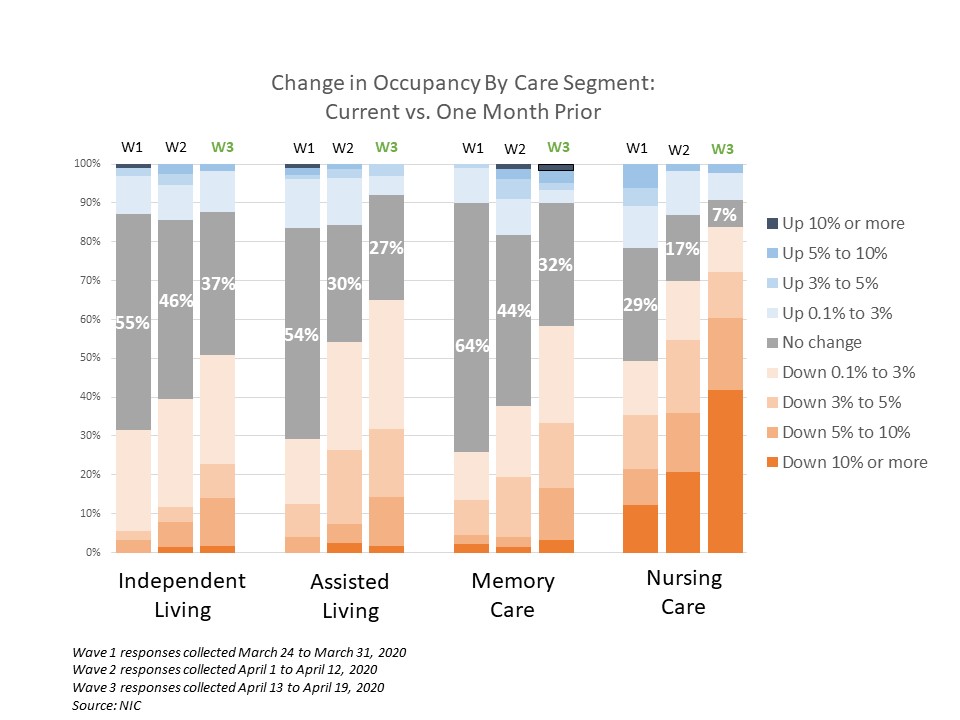

- Regarding the change in occupancy from one week ago, the independent living segment saw the most stability with approximately 70% noting no change. In contrast, approximately 40% of organizations with assisted living units report a downward change of less than 3%. While about a third of memory care units report a decline from a week ago, a growing share (10%) show steeper declines of 3% or more. Two-thirds of nursing care beds saw a decline from one week ago, with one-half reporting a decline of 3% or more.
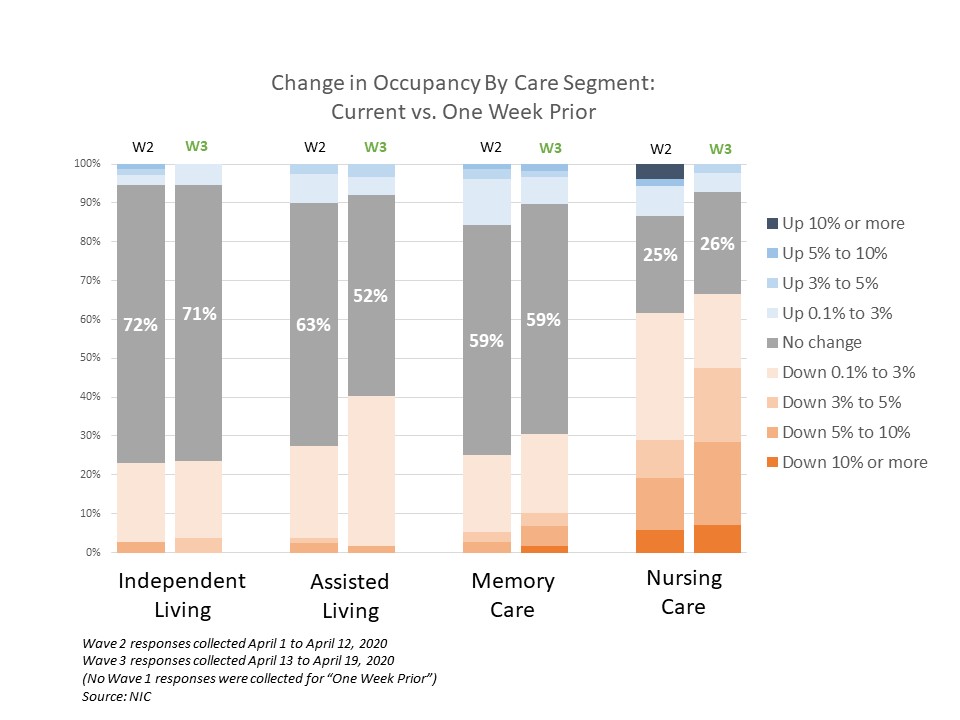

Pace of Move-Ins and Move-Outs
Respondents were asked: “Considering my organization’s entire portfolio of properties, overall, the pace of move-ins and move-outs by care segment in the past 30-days has…”
- In Wave 3, two-thirds to three-quarters of organizations reporting on their independent living, assisted living and memory care segments report that the pace of move-ins decelerated. Only one-third to one-quarter report no change in the pace of move-ins for these care segments.
- The majority of organizations reporting on their nursing care segments in Wave 3 note a deceleration in move-ins, compared to fewer than one-half in Wave 1.
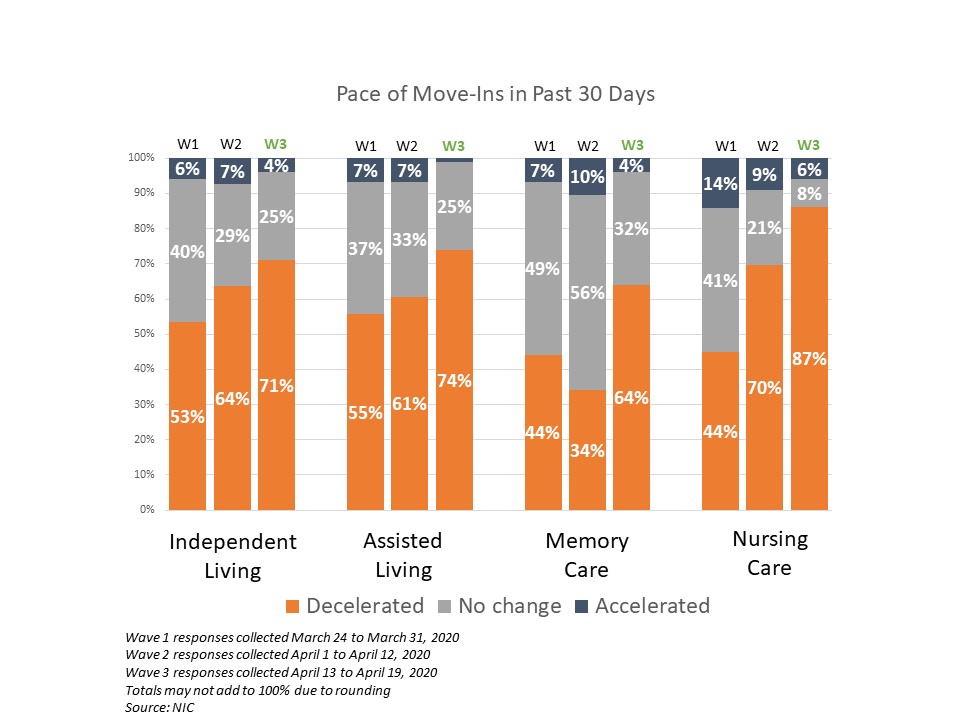
Reasons for Deceleration in Move-Ins
Respondents were asked: “The deceleration in move-ins is due to…”
- In Wave 3, two-thirds to one-half of respondents attributed the deceleration in move-ins to a slowdown in leads conversion/sales, or resident or family member concerns. Overall, slightly fewer respondents in Wave 3 cited an organization-imposed ban on settling new residents into their communities, and slightly more cited resident or family member concerns than in Wave 2.
- Other reasons for deceleration in move-ins written into the survey comments include staffing shortages, fewer hospital referrals and elective surgery rehab residents, inability to engage contractors deemed “non-essential workers” to complete unit renovations, and positive or suspected COVID-19 related moves of residents to isolated units.
- Shown below, the reasons for deceleration in move-ins in the past 30-days for Wave 3 are broken out by organizations without nursing care beds and organizations with any nursing care beds. Considering organizations with any nursing care beds, nearly one-half cite an organization-imposed ban (46%), and nearly one-quarter cite a government-imposed ban (23%).

- About two-thirds to three-quarters of organizations reporting on their independent living, assisted living and memory care units saw no change in move-outs in the past 30-days—a steady decline from Wave 1 to Wave 3 as shown in the chart below.
- Just over one-third of organizations with nursing care beds note an acceleration in move-outs in Wave 3.
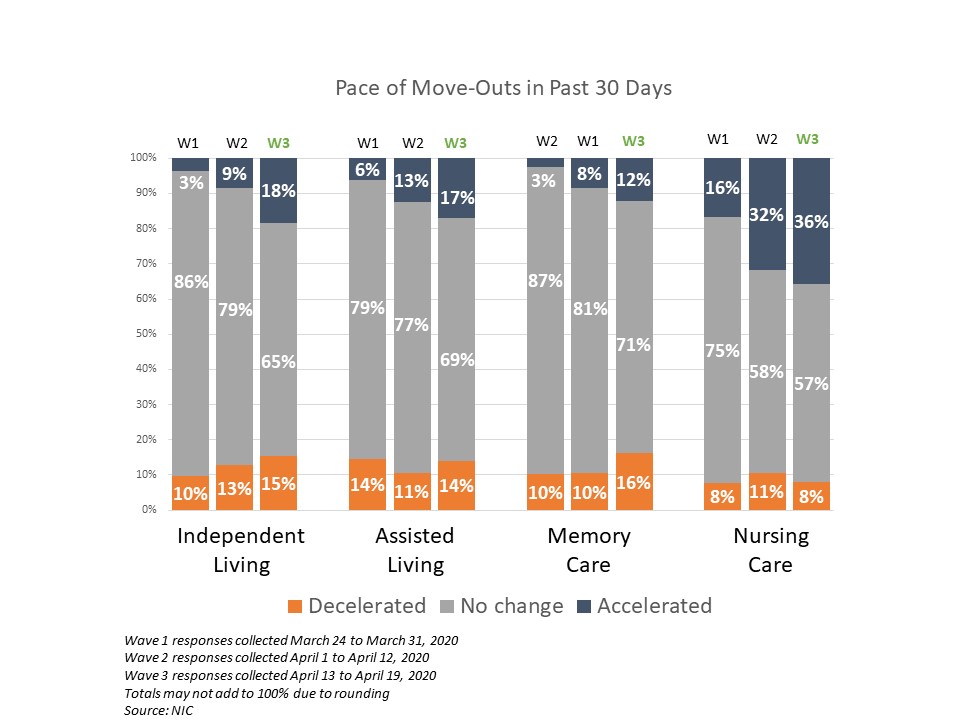
Mitigation Strategies for Labor Shortages
Respondents were asked: “My organization is back-filling property staffing shortages by utilizing… (Choose all that apply)”
- Consistent across all three-waves of the survey, most of the organizations report increasing overtime hours to mitigate staffing shortages (89% to 84%). However, fewer organizations in Wave 3 than the prior two waves of the survey are hiring agency or temp staff (36%), and professionals from other industries (22%).
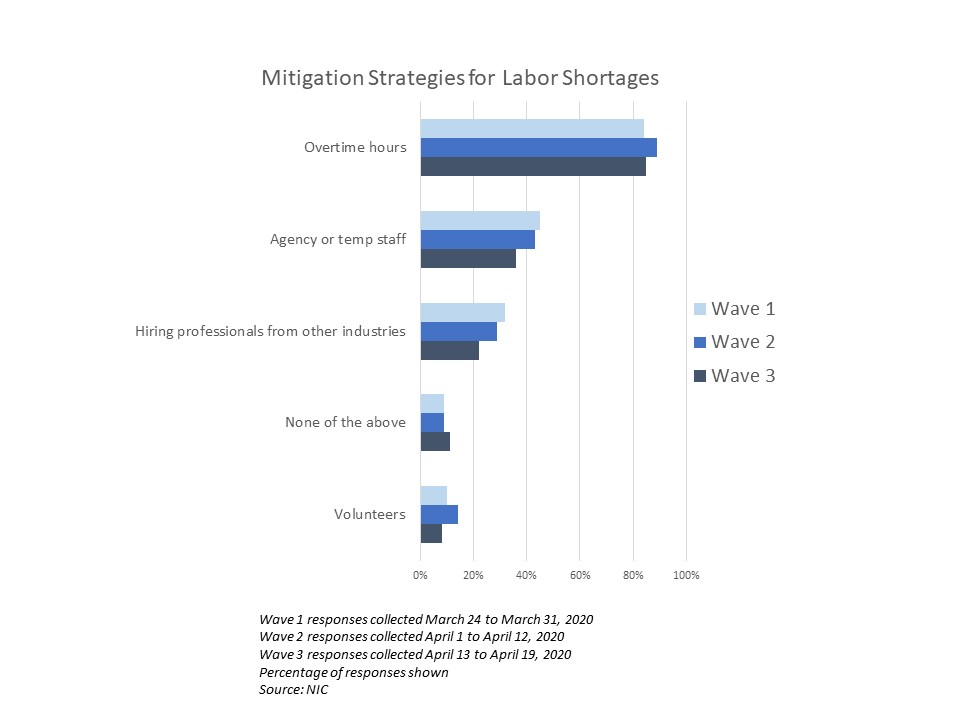
Supporting Property Staff
Respondents were asked: “My organization is supporting property staff who may be experiencing challenges by providing… (Choose all that apply)”
- Most respondents across all three waves of the survey report offering flexible work hours and remote work to support property staff. More organizations in Wave 3 than in Wave 1 are offering additional paid sick leave (58% vs. 47%).
- Many respondents in Wave 3 offered written comments about how their organizations are supporting property staff as the pandemic emergency continues for employees and their families, mentioning increases on wages, shift bonuses and incentive pay, access to on-site groceries and meals, emergency financial support programs, and temporary housing.
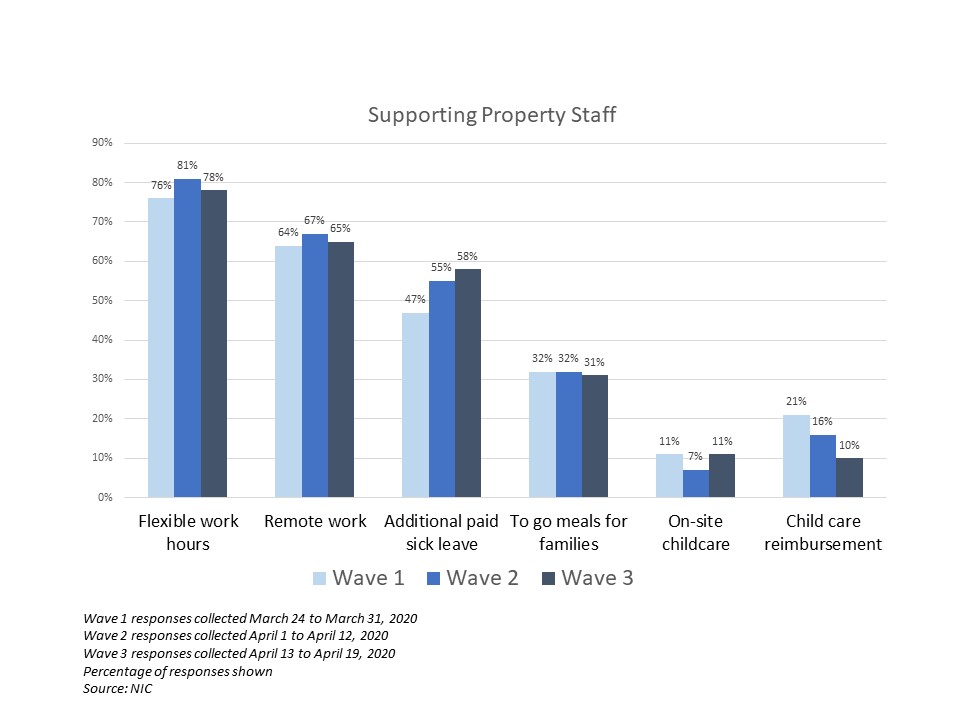
Development Pipeline Considerations
Respondents were asked: “My organization’s projected development pipeline going forward is expected to… (Choose all that apply)”
- There are generally minimal differences in expectations about organizations’ development pipelines across all three-waves of the survey. One-half in Waves 2 and 3 (46% and 49%, respectively) continue to expect no change in their development pipeline going forward, with one-quarter in Wave 3 expecting their development pipeline to decrease (27%), and 15% expecting it to increase.
- Uncertainty remains the primary reason for expected decline. Others cited concerns about the economy, restrictions on moving new residents in, access to capital/debt, and cashflow and liquidity issues.
NIC wishes to thank survey respondents for their valuable input and continuing support for this effort to bring clarity and transparency into market fundamentals in the seniors housing and care space at a time where trends are rapidly changing. Your support helps provide both capital providers and capital seekers with data as to how COVID-19 is impacting the space, helping leaders make informed decisions.
If you are an owner or C-suite executive of seniors housing and care properties and have not received an email invitation but would like to participate in the current Executive Survey, please click here for the current online questionnaire.